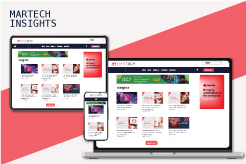Twilio, the customer engagement platform that drives real-time, personalized experiences for today’s leading brands, released its State of Nonprofit Digital Engagement Report from Twilio.org, which highlights the impact of new technology on engagement in the nonprofit sector, including public sector, healthcare and education institutions classified as 501c(3) organizations. In its second edition, the report reveals how nonprofit organizations are embracing and implementing new technology, such as AI, to engage their end users.
New MarTech News : DMi Partners Launches Lumina: New Platform for Affiliate Insights
“Building strong relationships with stakeholders is core to nonprofits’ ability to achieve their missions, and AI is helping them scale these engagements”
Twilio’s research shows that 90% of organizations surveyed in the nonprofit, education, and healthcare sectors are leveraging AI for one or more engagement and marketing use cases, including customer engagement platform, contact center, survey platform, customer analytics, and more. Nonprofits are integrating AI faster than the private sector, with 58% of nonprofits using AI with their CPaaS solution, compared to 47% of B2C businesses in the private sector. Further, 68% of nonprofits are using AI to analyze end user data to understand their needs and pain points, compared to 64% of B2C brands. Strong digital engagement is critical to success, according to 87% of nonprofits, to better reach, enroll, and serve new users, and they are turning to AI to accelerate and improve these efforts.
“Building strong relationships with stakeholders is core to nonprofits’ ability to achieve their missions, and AI is helping them scale these engagements,” said Erin Reilly, Chief Social Impact Officer & GM of the Social Impact Business at Twilio. “As nonprofit organizations continue to innovate with AI, listening to what their end users want and sharing how they are using technology transparently will be important to building trust. Those that can balance personalization and transparency with AI-driven digital engagement will have the ability to further their impact and scale their missions.”
AI helps nonprofit organizations across sectors achieve stronger returns from digital engagement
The report found that most nonprofits are aware of the need for better personalization, as 71% of organizations say personalized communications is a top priority in 2024, with AI boosting efforts. Across sectors, organizations are seeing success implementing AI. Examples include:
- In the healthcare sector, where patient satisfaction has a large impact on revenue, nonprofits are primarily leaning on AI to accelerate patient response times and improve patient satisfaction scores. As a result of implementing AI, 50% of healthcare organizations report better experiences for their patients.
- The education sector uses AI to connect with students across messaging platforms, as so many of them are from younger generations that are more apt to using messaging platforms. Education organizations report their top AI benefits include faster response times (47%), better data-driven decision making (41%), and improved student retention (40%).
- Nonprofits from traditional focus areas such as community improvement, housing or humanitarian aid report that their top benefits of AI in user engagement are better data-driven decision making (42%), faster response times (40%), improved participant retention (38%) and improved participant satisfaction (38%).
- Just over half of public sector organizations that use AI for constituent engagement experience higher constituent satisfaction (51%), better decision making (51%), and faster response times (50%).
For example, Polaris, the operator of the U.S. National Human Trafficking Hotline, built a contact center system within Twilio Flex that combined all their channels – IVR, telephony, SMS, chat, online webform, and email – into a unified, simple support platform. Now, hotline advocates have a simple and easy-to-navigate, single-pane interface for all outreach channels that displays relevant information about each potential trafficking situation to help them better serve the person needing support. This has ultimately led to a significant reduction in wait times, saving critical time in high-stakes cases where every moment counts. Plus, hotline advocates have experienced a 45% reduction in workflow steps, and half as many loading screens to wait through compared to their previous system, making their jobs easier, more impactful, and enabling them to help more victims in less time.
End users want more transparency around how nonprofits are using AI
While 83% of nonprofits believe they are transparent about how they use AI, only 38% of end users feel that nonprofits are transparent. This reflects a similar gap between for-profit companies and their customers, where 94% say they’re transparent with customers around how AI uses their data, while only 37% of customers agree. This presents an opportunity for nonprofits to improve as they increasingly adopt AI into their customer engagement. Nonprofits that clearly communicate with end users about how and why they’re using data will build trust and can drive better outcomes for their stakeholders, whether it be patients, students, constituents or beyond.
To keep pace with AI innovation and end user demands, nonprofits are becoming a new destination for developer jobs
88% of nonprofit organizations are planning to hire one or more developers in 2024. On average, organizations are planning to hire six developers this year. Additionally, roughly 3 out of 4 organizations plan to seek a moderate to large amount of outside technology support. With nonprofit organizations continuing to hire the right talent and supplement their workforce with pro bono work, they’ll be better positioned to accomplish their goals and deliver positive experiences for end users.
As nonprofit organizations continue to find new ways to provide value and relevance to their end users, AI is becoming a cornerstone technology that has the ability to create better experiences, stronger loyalty and help nonprofits achieve their missions.
For media inquiries, you can write to our MarTech Newsroom at news@intentamplify.com



